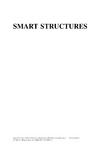Synthesizing knowledge acquired as a result of significant research and development over recent years,
Smart Structures clearly illustrates why these structures are of such intense current interest. Gaudenzi offers valuable insight into both how they behave and how and at what cost they could be designed and produced for real life applications in cutting edge fields such as vibration control, shape morphing, structural health monitoring and energy transduction.
Smart Structures offers a basic and fundamental description of smart structures from the physical, mathematical and engineering viewpoint. It explains the basic physics relating to the behaviour of active materials, gives the mathematical background behind the phenomena, and provides tools for numerical simulation. It also offers an insight into considerations related to the manufacturing, assembly and integration of smart structures.
Smart Structures is divided into 5 sections: in the first part a definition of smart structures is proposed, the motivation for developing a smart structure presented and the basic physics of active materials such aspiezoelectrics, electrostrictives, magnetostrictives and shape memory alloys briefly recalled. A second part is devoted to the mathematical modelling of piezoelectric bodies. The third part discusses actuation and sensing mechanisms based on which the active part of a smart structure will produce “results” on the passive one. The fourth part deals with active composites at the micromechanical and macromechanical level, and the fifth part is devoted to applications of smart structures with examples taken from the aerospace field.
This introduction to smart structures will be useful both for structural and mechanical designers, and for students and researchers at graduate level or beyond. The diverse industries involved in this rapidly evolving field include aerospace, automotive and bioengineering.
Content:
Chapter 1 Introduction to Smart Structures (pages 1–34):
Chapter 2 Mathematical Modelling of Piezoelectric Bodies (pages 35–65):
Chapter 3 Actuation and Sensing Mechanisms (pages 67–135):
Chapter 4 Active Composites (pages 137–160):
Chapter 5 Application of Smart Structures in Engineering Practice (pages 161–174):
 |
|
О проекте
|
|
О проекте


